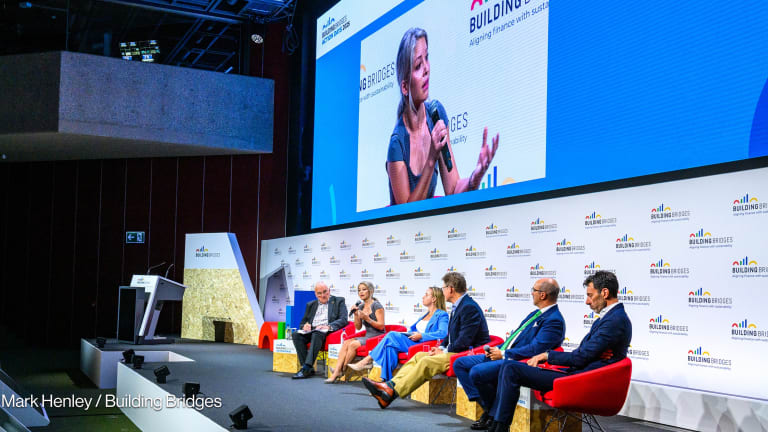'DFIs don't need more money,' says UK DFI official
Development finance institutions “have more than enough money; what we’re starving for are places to invest that money,” the chief operating officer of the United Kingdom's DFI, the CDC, told an audience last week, adding that it's time to address the obstacles in the way.
PARIS — The United Kingdom government’s development finance institution, formerly known as the Commonwealth Development Corporation but now known simply as CDC, might well have seen more growth in the last five years than any other government-founded DFI. Between 2016 and 2017 the U.K. government quadrupled the CDC’s investment ceiling to 6 billion British pounds ($8.37 billion) in development assistance, refocused its investments on riskier sectors and geographies, and grew its staff from around 60 to more than 200, all while maintaining a portfolio-wide average of at least 3.5 percent return on investments, as dictated by the Treasury. Yet Colin Buckley, CDC’s chief operating officer, told a crowd at the Organization for Economic Co-operation and Development in Paris last week, that regardless of the U.K. government’s buy-in, and an increasingly populous landscape of DFIs, these institutions “don’t need more money.” “The narrative of the moment is that we’ve got the capital part of this right, we now have to face the other blockages.” --— Colin Buckley, chief operating officer at CDC “We have new DFIs coming online — Canada, Australia, in the U.S. there are discussions about revamping OPIC, expanding its mandate, and we can’t ignore China, where there’s talk of trillions of dollars being made available for partnerships with the private sector, so large amounts of capital that are coming online — so I think the narrative of the moment is that we’ve got the capital part of this right, we now have to face the other blockages,” he said. DFIs “have more than enough money; what we’re starving for are places to invest that money,” he added. Buckley — who joined CDC in 2012 after creating and managing a social impact fund in Georgia, as well as managing investments for the Children’s Investment Fund Foundation — said he believes the DFIs are reaching “a plateau in the growth story,” whereby the capital for investment exists, but the “deals” are still locked up. “We need to unlock the deals, and then we’ll see an increasing need or appetite to take those on,” he said. A reinvention So what are those blockages? For one, Buckley said DFIs are simply unable to find companies willing to develop infrastructure projects in the right geographies despite plenty of capital flow, because they believe “development doesn’t pay.” CDC — which despite its new, riskier geographies, still catches criticism for insisting on an arguably safe 3.5 percent ROI — is involved in some promising infrastructure collaborations, but Buckley said it’s not enough. In 2015, CDC and the Norwegian Investment Fund jointly purchased equity in an energy infrastructure company called Globaleq Africa, which operates energy producing facilities across sub-Saharan Africa, where only 32 percent of the population has access to power. But DFIs struggle to get projects like these off the ground, he said. Second, Buckley joined in the common refrain across the development community that DFIs simply aren’t reaching small-to-medium enterprises. SME investment ensures a fertile private sector down the road, because, as Buckley said, “small businesses become big businesses.” “We’ve tried investment funds, we’ve tried funneling money through financial institutions, and we’re still not getting enough money into SMEs, so that’s also choking the pipeline,” he said. Many DFIs are also still modeled to provide debt over equity, Buckley explained, adding that “this is one of the fundamental changes being asked of DFIs, to move from a loan to an equity structure,” which he said is “fundamentally harder” and more demanding than simply making credit decisions. Asked by Devex how CDC can shoulder more risk in order to invest in SMEs, Buckley said “it’s not about risk,” but about the unwillingness of financial intermediaries in developing countries to work with SMEs. “I think it’s just going to take some time for DFIs to reinvent themselves, or for DFIs to come up with alternative intermediaries that are consistent with that longer term public good development impact requirement.” Third, Buckley said, DFIs and the broader development community need to do more to create “capital ecosystems” in developing countries, “which internally can start to allocate money to startups, venture capitals, and flotations and so on,” he said. The evolving remit of DFIs must include mobilizing money as well as debt. “We’re asking them to manage investors, to mobilize money, to start creating businesses rather than investing,” he said. What can governments do to help? Owned by the U.K. Department for International Development, CDC can now access up to 6 billion pounds ($8.37 billion) of official development assistance until 2021, about 4 percent of the U.K.’s projected aid budget for the period 2016-2021. DFID leadership is also able to raise that investment ceiling to 12 billion pounds ($16.74 billion), with parliamentary approval. With that unprecedented financial backing from a government that prides itself on innovative economic development, Buckley said there are still more effective ways governments should get involved in the work of DFIs. First, Buckley said, governments can do more to draw banks back to riskier geographies. The Third Basel Accord, or “Basel III” put new restrictions on banks’ equity to debt ratio following the 2009 financial crisis, but Buckley said the regulations, as well as the new “know your client” regulations, led to a mass exodus of financial institutions from developing markets. “I think governments need to re-examine the requirements we’re placing on the capital charges for our financial institutions, with a lens that permits them to re-engage in economic development,” he said. “[These banks] were one of the primary drivers of development in our geographies and sadly they are no longer.” Next, he said governments could loosen restrictions around how pension funds invest, opening up a new source of flexible capital. A 2016 study by Willis Towers Watson estimated that pension funds control about $36 trillion in assets globally, but most countries’ pension regulations impose a fiduciary duty on pension administrators that makes them favor financial firms when it comes to deciding on investments. “If we can mobilize even very modest percentages of those pension funds, we really do have a shot at the billions to trillions agenda.” --— “We have to revise those regulatory frameworks to at least let pension administrators accept the designation of pension holders, put some of their pension in some type of impact investment,” Buckley suggested. “And if we can mobilize even very modest percentages of those pension funds, we really do have a shot at the billions to trillions agenda.” Finally, Buckley said, governments can help incentivize multinational corporations to take a more “impact-driven” view of business. Echoing statements by former head of the French Development Agency Jean-Michel Severino, Buckley said the regulatory landscape is “highly fragmented” across different countries, but that “there needs to be a consistent message that boards of directors can take social impact into account when they make capital allocations decisions.” He blamed multinationals’ boards of directors’ “broad fiduciary duty” to shareholders to generate returns, saying it was up to governments to shift the regulatory landscape to free up corporations to take on a more impact-driven approach to business. Update, Feb. 8: This story was amended to clarify that the Treasury-set return rate for CDC is 3.5 percent. Read more Devex coverage on the future of the U.K. aid.
PARIS — The United Kingdom government’s development finance institution, formerly known as the Commonwealth Development Corporation but now known simply as CDC, might well have seen more growth in the last five years than any other government-founded DFI. Between 2016 and 2017 the U.K. government quadrupled the CDC’s investment ceiling to 6 billion British pounds ($8.37 billion) in development assistance, refocused its investments on riskier sectors and geographies, and grew its staff from around 60 to more than 200, all while maintaining a portfolio-wide average of at least 3.5 percent return on investments, as dictated by the Treasury.
Yet Colin Buckley, CDC’s chief operating officer, told a crowd at the Organization for Economic Co-operation and Development in Paris last week, that regardless of the U.K. government’s buy-in, and an increasingly populous landscape of DFIs, these institutions “don’t need more money.”
“We have new DFIs coming online — Canada, Australia, in the U.S. there are discussions about revamping OPIC, expanding its mandate, and we can’t ignore China, where there’s talk of trillions of dollars being made available for partnerships with the private sector, so large amounts of capital that are coming online — so I think the narrative of the moment is that we’ve got the capital part of this right, we now have to face the other blockages,” he said.
This story is forDevex Promembers
Unlock this story now with a 15-day free trial of Devex Pro.
With a Devex Pro subscription you'll get access to deeper analysis and exclusive insights from our reporters and analysts.
Start my free trialRequest a group subscription Printing articles to share with others is a breach of our terms and conditions and copyright policy. Please use the sharing options on the left side of the article. Devex Pro members may share up to 10 articles per month using the Pro share tool ( ).
Molly Anders is a former U.K. correspondent for Devex. Based in London, she reports on development finance trends with a focus on British and European institutions. She is especially interested in evidence-based development and women’s economic empowerment, as well as innovative financing for the protection of migrants and refugees. Molly is a former Fulbright Scholar and studied Arabic in Syria, Jordan, Egypt and Morocco.








